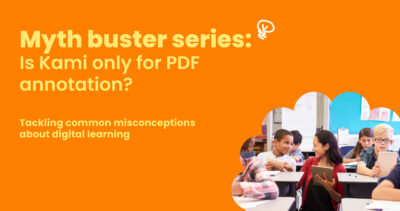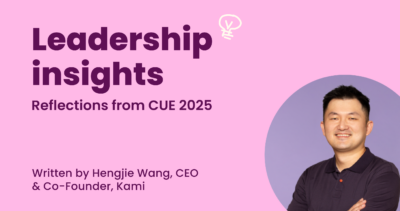Last week, alongside colleagues from Kami and over 4,000 dedicated educators and administrators, I attended the inspiring CUE 2025 conference in Palm Springs. This event is always a valuable moment to take stock of key educational trends and pressing challenges shaping our schools—particularly as technology continues to transform learning experiences.
Navigating funding uncertainty
One clear takeaway from this year’s conference was the heightened concern around future funding. Conversations in the conference hall repeatedly circled back to uncertainty regarding federal budgets and potential structural changes in funding distribution. Educators are understandably anxious, and eager to clarify the various scenarios that could take shape – many of which point to more localized funding models involving grants or voucher programs.
The underlying message, however, was clear: educators and administrators still want solutions that ensure educational quality remains high, even as budgets tighten. My conversations at CUE certainly underscored educators’ resilience and adaptability, showcasing a proactive stance toward exploring funding alternatives as well as an appetite for sustainable, budget-conscious solutions like Kami.
If funding uncertainties are affecting your planning, please connect with our Kami team. We’re closely tracking these dynamics and can help you navigate this evolving landscape.
AI and the quest for practical professional development
As you’d expect for a large conference in 2025, Artificial Intelligence naturally dominated many discussions, reflecting educators’ keen interest—and cautious optimism—in this transformative technology. The collective desire for meaningful, practical AI training was palpable. The teachers whom I spoke with consistently expressed the need for professional development opportunities that are both accessible and immediately applicable in their classrooms.
Our recent “Educator Insights Survey” revealed that nearly half of educators surveyed have not received sufficient professional development related to technology integration. Clearly, this gap must be addressed if we’re to leverage AI effectively for enhanced student outcomes. The task ahead for edtech providers, including Kami, is not just to develop robust tools, but to partner closely with educators to ensure they’re fully empowered to utilize these technologies.
Accessibility: Essential, not optional
Accessibility remains front and center as a critical priority for educators. Many of the conversations I had echoed findings from Kami’s recent report, “The State of SPED and ELL Technology,” which highlighted persistent gaps in speech-to-text functionality and multilingual support. Enhancing accessibility isn’t just about compliance—it’s about unlocking potential for every learner, especially students who are multilingual or have special educational needs.
My colleagues at Kami remain deeply committed to bridging these accessibility gaps. Without revealing too much prematurely, we’re excited to announce that innovative solutions specifically designed to support ELL and SPED students are currently in development. Any educators interested in collaborating on early testing should feel free to reach out directly.
Beyond PDF annotation: Discovering the true potential of edtech
Lastly, CUE 2025 reaffirmed the importance of clear communication around edtech capabilities. Kami has long been recognized for PDF annotation, but as educators who visited our stand and break-out spaces during the conference discovered, our solutions extend far beyond this. They include real-time student insights, dynamic assessment capabilities, personalized learning pathways and so much more! It was rewarding to witness educators’ excitement upon realizing the broader impact Kami can have in their classrooms.
Ultimately, the conference highlighted a powerful truth: effective edtech supports educators’ diverse needs, facilitates meaningful student engagement, and adapts flexibly to the rapidly evolving educational landscape.
Final reflections
Events like CUE reinforce our belief in collaboration as the cornerstone of educational innovation. Kami will continue sharing insights and facilitating dialogue on these critical topics. As always, your feedback is invaluable, so please stay connected through our articles, webinars, and reports – all of which are available on our website.
Thank you for your continued passion and commitment to shaping the future of education.
Hengjie Wang
CEO & Co-founder, Kami
You may also like

Engaging every learner: How Kami transforms passive lessons into active learning

Myth Buster: Is Kami only for PDF annotation?


